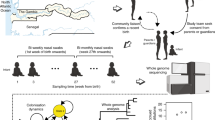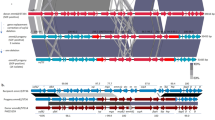Abstract
Serotype M1 group A Streptococcus strains cause epidemic waves of human infections long thought to be mono- or pauciclonal. The gene encoding an extracellular group A Streptococcus protein (streptococcal inhibitor of complement) that inhibits human complement was sequenced in 1,132 M1 strains recovered from population-based surveillance of infections in Canada, Finland and the United States. Epidemic waves are composed of strains expressing a remarkably heterogeneous array of variants of streptococcal inhibitor of complement that arise very rapidly by natural selection on mucosal surfaces. Thus, our results enhance the understanding of pathogen population dynamics in epidemic waves and infectious disease reemergence.
This is a preview of subscription content, access via your institution
Access options
Subscribe to this journal
Receive 12 print issues and online access
$209.00 per year
only $17.42 per issue
Buy this article
- Purchase on Springer Link
- Instant access to full article PDF
Prices may be subject to local taxes which are calculated during checkout




Similar content being viewed by others
References
Krause, R.M. & Fauci, A. in Emerging Infections (Academic Press, San Diego, 1998).
Hennessy, T.W. et al. A national outbreak of Salmonella enteritidis infections from ice cream. N. Engl. J. Med. 334, 1281 –1286 (1996).
Armstrong, G.L., Hollingsworth, J. & Morris, J.G. Jr. Emerging foodborne pathogens: Escherichia coli O157:H7 as a model of entry of a new pathogen into the food supply of the developed world. Epidemiol. Rev. 18, 29–51 (1996).
Piffaretti, J.-C. et al. Genetic characterization of clones of the bacterium Listeria monocytogenes causing epidemic disease. Proc. Natl. Acad. Sci. USA 86, 3813–3822 ( 1989).
Wachsmuth, I.K., Blake, P.A. & Olsvik, O. Vibrio cholerae and Cholera (American Society for Microbiology Press, Washington, D.C., 1994).
Morelli, G. et al. Clonal descent and microevolution of Neisseria meningitidis during 30 years of epidemic spread. Mol. Microbiol. 25, 1047–1064 (1997).
Webster, R.G. in Emerging Infections (eds. Krause, R.M & Fauci, A.) 275– 300 (Academic Press, San Diego, 1998).
Fischetti, V.A. Streptococcal M protein: molecular design and biologic behavior. Clin. Microbiol. Rev. 2, 285–314 (1989).
Musser, J.M. & Krause, R.M. in Emerging Infections (eds. Krause, R.M. & Fauci, A.) 185–218 (Academic Press, San Diego, 1998).
Martin, D.R. & Single, L.A. Molecular epidemiology of group A streptococcus M type 1 infections. J. Infect. Dis. 167, 1112–1117 (1993).
Muotiala, A., Seppala, H., Huovinen, P. & Vuopio-Varkila, J. Molecular comparison of group A streptococci of T1M1 serotype from invasive and noninvasive infections in Finland. J. Infect. Dis. 175, 392–399 (1997).
Musser, J.M. et al. Genetic diversity and relationships among Streptococcus pyogenes strains expressing serotype M1 protein: recent continental spread of a subclone causing episodes of invasive disease. Infect. Immun. 63, 994–1003 ( 1995).
Cleary, P.P. et al. Clonal basis for the resurgence of serious Streptococcus pyogenes disease in the 1980s. Lancet 339, 518–521 (1992).
Akesson, P., Sjoholm, A.G. & Bjorck, L. Protein SIC-a novel extracellular protein of Streptococcus pyogenes interfering with complement function. J. Biol. Chem. 271, 1081–1088 ( 1996).
Lubinski, J.M. et al. Herpes simplex virus type 1 glycoprotein gC mediates immune evasion in vivo. J. Virol. 72, 8257 –8263 (1998).
Stockbauer, K.E. et al. Hypervariability generated by natural selection in an extracellular complement-inhibiting protein of serotype M1 strains of group A Streptococcus . Proc. Natl. Acad. Sci. USA 95, 3128 –3133 (1998).
Hoe, N. et al. Rapid subtyping of serotype M1 Group A Streptococcus strains by automated sequencing of the sic gene encoding streptococcal inhibitor of complement and a chromosomal region with multiple direct repeat sequences. Emerg. Infect. Dis. 5, 254– 263 (1999).
Davies, H.D. et al. Invasive group A streptococcal infections in Ontario, Canada. N. Engl. J. Med. 335, 547– 554 (1996).
Zurawski, C.A. et al. Invasive group A streptococcal disease in metropolitan Atlanta: a population-based assessment. Clin. Infect. Dis. 27 , 150–157 (1998).
Ramsay Taylor, W. The classification of amino acid conservation. J. Theor. Biol. 119, 205–218 ( 1986).
Fitch, W.M. On the problem of discovering the most parsimonious trees. Am. Nat. 3, 223–257 ( 1977).
Swofford, D.L. in PAUP: Phylogenetic Analysis Using Parsimony (Illinois Natural History Survey, Champaign, Illinois, 1993).
Tajima, F. Statistical method for testing the neutral mutation hypothesis by DNA polymorphism. Genetics 123, 585–595 (1989).
Fu, Y.-X. Statistical properties of segregating sites. Theor. Popul. Biol. 48, 172–197 ( 1995).
Harbaugh, M. P., Podbielski, A., Hugl, S. & Cleary, P.P. Nucleotide substitutions and small-scale insertion produce size and antigenic variation in group A streptococcal M1 protein. Mol. Microbiol. 8, 981–991 (1993).
de Malmanche, S.A. & Martin, D.R. Protective immunity to the group A Streptococcus may be only strain specific. Med. Microbiol. Immunol. 183, 299– 306 (1994).
Jones, K.F., Hollingshead, S.K., Scott, J.R. & Fischetti, V.A. Spontaneous M6 protein size mutants of group A streptococci display variation in antigenic and opsonogenic epitopes. Proc. Natl. Acad. Sci. USA 85, 8271–8275 ( 1988).
Fischetti, V.A., Jarymowycz, M., Jones, K.F. & Scott, J.R. Streptococcal M protein size mutants occur at high frequency within a single strain. J. Exp. Med. 164, 971– 980 (1986).
Hollingshead, S.K., Fischetti, V.A. & Scott, J.R. Size variation in group A streptococcal M protein is generated by homologous recombination between intragenic repeats. Mol. Gen. Genet. 207, 196–203 (1987).
Villasenor, A., McShan, W.M., Salmi, D. & Stevens, D.L. Variation in susceptibility to opsono-phagocytosis by strains of a M-1 clone of group A Streptococcus (GAS) could be associated with diversity in the sequence of the emm1 gene. Abstract E-61 (American Society for Microbiology 98th General Meeting, Atlanta, Georgia, 1998 ).
Ou, C-Y. et al. Molecular epidemiology of HIV transmission in a dental practice. Science 256, 1165–1171 (1992).
Garcia, O. et al. Evolutionary pattern of human respiratory syncytial virus (subgroup A): cocirculating lineages and correlation of genetic and antigenic changes in the G glycoprotein. J. Virol. 68, 5448–5459 (1994).
Domingo, E. & Holland, J.J. RNA virus mutations and fitness for survival. Annu. Rev. Microbiol. 51, 151–178 (1997).
Beall, B., Facklam, R., Hoenes, T. & Schwartz, B. Survey of gene sequences and T-antigen types from systemic Streptococcus pyogenes infection isolates collected in San Francisco, California; Atlanta, Georgia; and Connecticut in 1994 and 1995. J. Clin. Microbiol. 35, 1231–1235 (1997).
Acknowledgements
We thank W.A. Keitel and J. Dale for critical reading of the manuscript, R.S. Orkiszewski for the mass spectroscopy analysis, I. Eckstrand for support, and S. Ruusunen, R. Scotford and E. Siren for technical assistance. We thank A. Muotiala, H. Seppala, P. Huovinen and the Finnish Study Group for Antimicrobial Resistance for their work and support during collection of the Finnish strains. Specimens from the United States were provided by the Emerging Infections Program Network/Active Bacterial Core Surveillance, supported by a cooperative agreement between the Centers for Disease Control and Prevention and the State Health Departments of California, Connecticut, Georgia, and Minnesota. This study was supported by United States Public Health Service Grants AI-33119 to J.M.M. and GM-50428 to Y.-X. F., and the Canadian Bacterial Disease Network.
Author information
Authors and Affiliations
Corresponding author
Rights and permissions
About this article
Cite this article
Hoe, N., Nakashima, K., Lukomski, S. et al. Rapid selection of complement-inhibiting protein variants in group A Streptococcus epidemic waves. Nat Med 5, 924–929 (1999). https://doi.org/10.1038/11369
Received:
Accepted:
Issue Date:
DOI: https://doi.org/10.1038/11369
This article is cited by
-
Epidemiology: Gray immunity model gives qualitatively different predictions
Journal of Biosciences (2024)
-
Vaccine-induced, but not natural immunity, against the Streptococcal inhibitor of complement protects against invasive disease
npj Vaccines (2021)
-
Prevalence of a Streptococcal Inhibitor of a Complement-Mediated Cell lysis-like Gene (sicG) in Streptococcus Dysgalactiae subsp. Equisimilis
Current Microbiology (2011)
-
Epidemiology, outcome and emm types of invasive group A streptococcal infections in Finland
European Journal of Clinical Microbiology & Infectious Diseases (2010)



